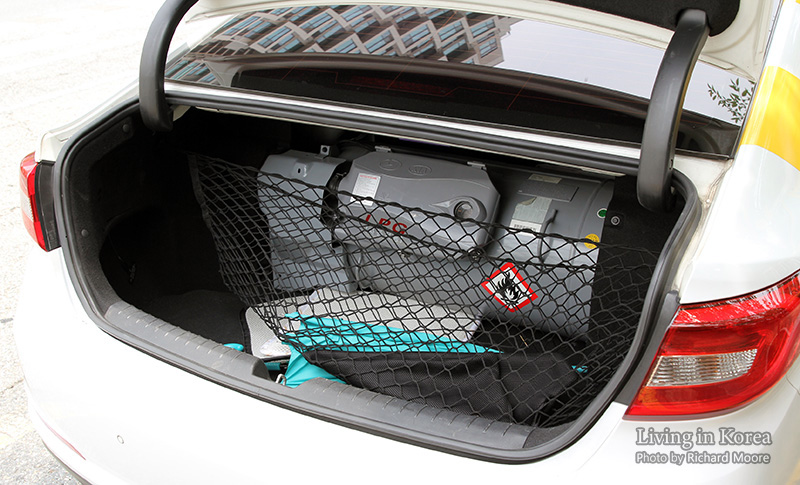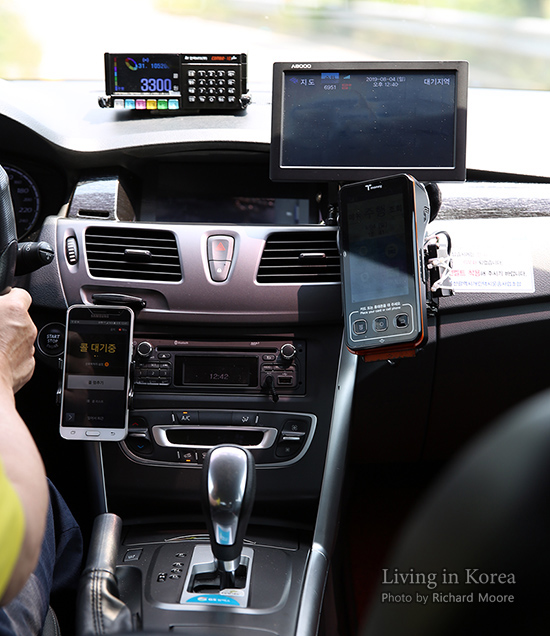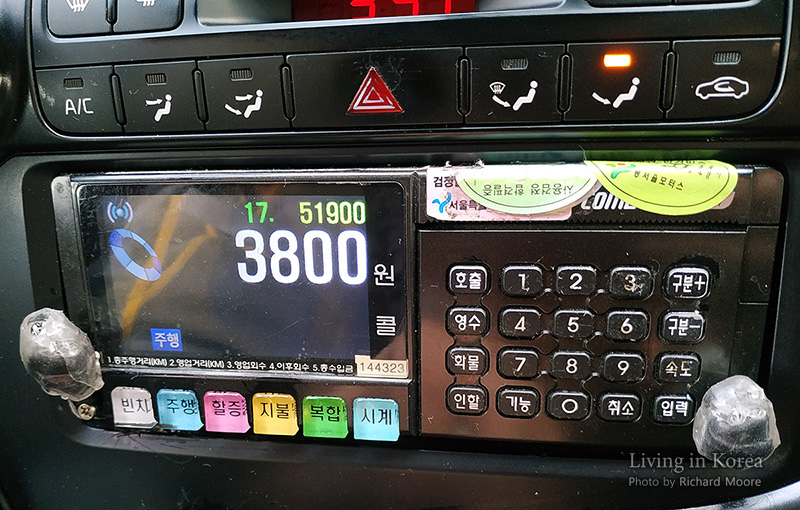Now that you have gotten a taxi, you may need to tell the driver to open the drunk so you can add a suitcase or two. The word for trunk in Korean is 트렁크 (teureongkeu) and is a loanword of the word “trunk”. Usually you don’t need to say anything as they’ll see your bags and you walking toward the rear of the taxi. Simply saying 트렁크 is enough or if you want a full sentence you can say:
트렁크 열어주세요.
Teureongkeu yeoreojuseyo.
Please open the trunk.
As most taxis run on LPG, the tank for this gas is in the trunk and takes up roughly half of the trunk space. Keep this limitation in mind before you attempt to bring a large number of luggage within a single taxi.

It is polite to greet the driver and for the driver to greet you but this don't always happen. But instead of saying “hello” in English, it is best to say “hello” in Korean. This is positive in several aspects as a greeting is a general courtesy, shows you are living in Korea, and shows you have an interest in the Korean language.
안녕하세요. (安寧하세요)
Annyeong haseyo.
Hello. (Can literally be translated as "peace be with you".)
If you reserved the taxi, the driver might want to confirm you are the correct passenger. If you use a “call service” the driver might use the term 콜택시 (koltaeksi, literally “call taxi”). If you used Kakao T the driver might use the name of the app; 카카오택시 (kakao taeksi, literally “Kakao Taxi”). A full question sentence might be:
카카오택시하셨죠?
Kakaotaeksi hasyeotjyo?
Did you use Kakao Taxi?
"Yes" in Korean is 네 (ne) and "no" in Korean is 아니요 (aniyo).
If you did not reserve a taxi, you will need to tell the driver where you are going. You can simply say the location, such as X Hotel or Myeongdong, or you can be more specific such as saying the exit number of a subway station (exit 6, 6번출구, 六番出口, yukbeonchulgu).
...에 가주세요.
...e gajuseyo.
Please go to...
As soon as the driver is confident of the location, they will turn off the 빈차 (빈車, bincha) light displayed outside of the taxi, which tells people the taxi is available, and will turn on the taxi meter (자동차 미터기, 自動車 meter器, jadongcha miteogi). This will be installed somewhere between the dashboard and the gear stick. In this image, the meter has been mounted on the dashboard. To the right is a GPS device (네비게이션, nebigeisyeon, literally “navigation”) which sometimes displays advertisement, below the GPS is a payment device and receipt printer from the transport company T Money, and the smartphone below and to the left is displaying the driver’s version of the app Kakao Taxi which is used to accept requests for taxis in a first come, first served fashion. If you want to see the image and words more clearly, click the picture to see a larger version.

Here is a close-up of a taxi meter. The number 3800 is telling us the current price is KRW 3,800. The circle with several shades of blue will change when the taxi is in motion with each segment going from light, medium, and dark in a circular pattern. As taxi fare is determined by a mixture of time and distance traveled, this is to indicate when the taxi is in motion and the speed of the taxi will be reflected here as well. Older versions of this included a horse galloping. The stickers on the top right and the metal seals on the bottom right and left are to prevent someone from illegally modifying the meter. These stickers are from Seoul and not every city has stickers, but most if not all cities have metal seals. This meter is more unique as there is thin plastic around the seals. We can also see the word 주행(走行, juhaeng) lit up on the display. This term means the meter has been turned on. If you want to see the image and words more clearly, click the picture to see a larger version.

Here is a slightly different version from the company Cash Bee, which competes with T Money in the market of transport cards. The lowercase “b” logo will change colors when the taxi is in motion, just like the circle in the above example. The price is currently KRW 15,420 and you’ll notice 시외 (市外, sioe) and 20%. 시외 is to show we’ve crossed from one city to another, much like when taking a taxi from Osong Station in route to Sejong City, which is currently the closest train station to Sejong. Crossing from one city to another will incur an additional surcharge, in this case 20%. If you want to see the image and words more clearly, click the picture to see a larger version.

The starting rate for taxis will be determined by negotiations between the city transit authority and taxi groups or unions. As this is city specific, expect the price to be slightly different when you travel to another city or another region of the country. If you want to see breakdowns by type of taxi, size of taxi, city, times, and more, visit the related pricing page (Korean language only) from the Korea National Joint Conference of Taxi Association (전국택시운송사업조합연합회, 全國택시運送事業組合聯合會, jeongung taeksi unsong saeom joham yeonhapoe). The fare you will eventually pay is set by the basic rate for the first 2 to 3 km (ranges from around KRW 2,800 to 6,500), distance-based fee of KRW 100 every X number of meters (ranges from around 126 to 164), time-based fee of KRW every X seconds (ranges from around 31 to 51), and additional percentage-based fees can be added for driving from midnight to 4 AM, providing rides into a city the taxi is not allowed to pick up new passengers in, and/or a few other things.
It is recommended that you make sure the meter is running. If the meter has not been turned on, it will be difficult to calculate your fare. Therefore, it is in your best interest to take a quick glance at the meter. Exception will be if you are riding in a “call van” (콜밴, colban) which will have a set price for the trip.
Some drivers are very chatty and would love to have a conversation with you while others will drive in silence or with the radio playing. There is no standard in this sense.
Here are a few more sentences which you might find helpful while riding in a taxi.
좀 더 빨리 가주세요.
Jom deo ppalli ga juseyo.
Please drive faster.
좀 더 천천히 가주세요.
Jom deo cheoncheonhi gajuseyo.
Please drive slower.
Now that you’ve ridden in a taxi, let’s go over best practices and what to expect when for payment and exiting.